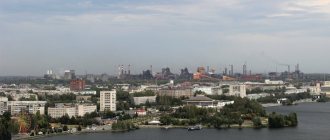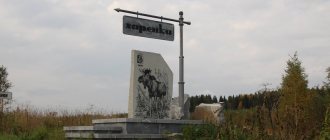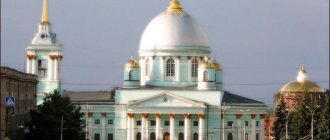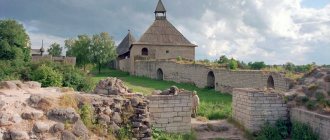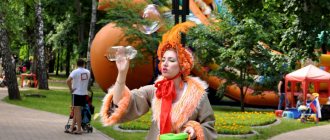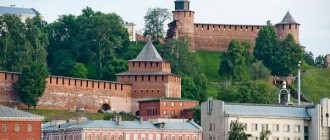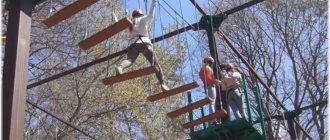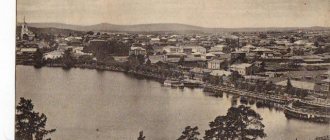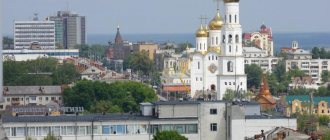Nizhne Tagil Museum-Factory
It turns out that very close to Yekaterinburg, literally 140 km away, in Nizhny Tagil there is the only factory-museum in Russia, an open-air museum. Not only the only one in Russia, but also one of the few of its kind in the world. As the guide told us, not only Russians, but also foreigners willingly visit the plant.
A little from the history of the Nizhne Tagil plant, also known as the Demidov plant, or, in Soviet times, the plant named after. Kuibysheva.
“Among the boundless Ural forests, on the fast mountain river Tagil at the foot of Magnit Mountain, factory buildings rose in 1725.
Articles on the topic
September 14, 2012
Abandoned quarry "Old Lens"
The noisy breathing of the domain among the forest silence and the dull blows of heavy hammers, flashes in the darkness of the night and sheaves of sparks from liquid metal and flashy slag announced the birth of the Nizhne-Tagil iron smelting and iron-making plant, authors M.V. Kuzovkova, S.V. Ustyantsev, S. Khlopotov .I., scientific editor, Doctor of Historical Sciences Postnikov S.P.)
The builder of the plant was Akinfiy Demidov, the plant was part of the Demidov mining empire.
The plant has a rich history.
In the 30s of the 18th century, the blast furnaces of the plant were the best in the world and surpassed the blast furnaces of Europe; in the 70s-80s of the 18th century, Tagil craftsmen mastered the technology of rolling sheet iron. In 1895, a power station was built. During the First World War and the Civil War, the plant fell into disrepair and stopped. In the early 1920s, a revival began. In 1930, two new blast furnaces were built, which have survived to this day. In 1957, the Nizhne-Tagil plant became part of NTMK, and from that time on, production at the old plant began to fade. The rolling shop was stopped in 1961, the open-hearth shop in 1980, and the blast furnace shop in 1987.
But the plant does not die and since 1987 it has been transformed into an industrial museum-factory of the history of ferrous metallurgy technology, now the Nizhny Tagil Museum-factory.
You can learn more about the history of the plant on a tour or by purchasing a booklet, which is sold in the local history museum at the ridiculous price of 1 ruble. 50 kopecks
We will not talk about all the objects of the excursion; we will focus only on the most interesting from our point of view - the blast furnace and open-hearth shops.
Two furnaces have been preserved in the blast furnace shop. It was in these furnaces that cast iron was produced.
Cast iron is an alloy of iron and carbon. The carbon content in cast iron is not less than 2.14%. If there is less carbon, then it is steel, which is produced in the open-hearth shop. Cast iron was produced from iron ore and coal, and later coke.
The mixture of ore and coal (charge) was lifted to the very top of the blast furnace, first with the help of a winch, and since 1971 with trolleys like these.
Next, the charge was loaded from above into a blast furnace, and heated air rushed towards the charge, which was pumped using blowers. The final reaction was reduced to the interaction of iron oxides and carbon monoxide, as a result of which cast iron was obtained.
The professionalism of workers in the 18th century servicing blast furnaces was so high that through special “peepers” they could determine whether it was necessary to add oxygen, pressure and how much time was left before the completion of melting by the color of the flames in the furnace.
September 18, 2013
Degtyarsky abandoned mine
A blast furnace is a furnace of continuous production; if it stops, then all the cast iron will harden, “goat.” Therefore, production here did not stop for an hour. Before the invention of electricity, in the dark, cast iron was poured by torchlight.
When the cast iron was ready, a tap hole was broken at the base of the blast furnace. At first they did this with a crowbar, later they started using an electric drill. First, the slag and then the cast iron were released through a hole into sand molds. Now you can see special grooves along which the cast iron rushed into the containers.
Not far from the blast furnace shop there is an open-hearth shop. There is no roof in the workshop, only floor trusses remain.
Open hearth furnaces are not as tall as blast furnaces. The starting materials (cast iron, iron scrap, ore) were loaded into them from the side.
The process used a Prudenko charging machine, which operated until 1978. It ran on both electricity and fuel oil. “Giant Spoon,” that’s what we called this mechanism.
During the tour, you will also be shown a radial settling tank and scrubber, a power plant building and a rolling shop, in which no equipment has been preserved at all, only floor trusses remain.
In addition to excursions on the territory, you can meet working workshops that work for the benefit of NTMK, and volunteers, former employees of the plant who, being retired, come to the plant every Wednesday to remove excess garbage.
We recommend visiting it for schoolchildren studying the topic “Metals” in chemistry lessons, former employees of metallurgical industries, lovers of beautiful scenery for photo shoots and simply curious people.
The museum is open to the public from May 1 to October 1 , Monday to Saturday.
Children are allowed from 14 years old.
The cost of the excursion for an adult group is 600 rubles (no more than 10 people). Maximum group - 15 people. Each additional + 60 rubles.
Phone number for ordering excursions 8 (3435) 41 64 01.
We would like to express our gratitude to our guide Kristina Mikheeva, as well as to the director of the Museum-Factory, Elvira Raisovna Merkusheva, for the opportunity to film.
Uralweb.ru
THE COOLEST MUSEUMS OF NIZHNY TAGIL
Nizhny Tagil
is not the most tourist place, not only in the Sverdlovsk region, but also in Russia. It is very famous for its huge factories, such as the Nizhny Tagil Iron and Steel Works (NTMK) and Uralvagonzavod (UVZ), which are its city-forming enterprises. Also among such enterprises one can put “UralKhimPlast” and “Sverdlovsk Railway”, which successfully exports the products of these enterprises. Yes, I still work there...
A LITTLE EXCURSION INTO THE HISTORY AND GEOGRAPHY OF MY CITY
My favorite city is located in the Sverdlovsk region, near the conventional border between Asia and Europe, conveniently located on the eastern slope of the ancient Ural Mountains. The area of the city is slightly less than 300 square meters. kilometers, which also allows it to take 2nd place in terms of occupied area among the cities of the Sverdlovsk region. Local population slightly exceeds 350,000
“Magnit Gora” (High) was first mentioned in the 2nd half of the 17th century, but the mining of iron and copper ore began in 1721, when A. N. Demidov built 2 plants: Vyisky copper smelter (10/23/1722 ) and Nizhny Tagil iron-making, iron-smelting (12/25/1725). The Nizhny Tagil plant in the 18th century became one of the most significant factories in Europe and Tagil iron with the “Old Sable” brand began to be bought by the British, Dutch, French and Swedes
As mentioned above, the history of the formation of the city began back in 1722, and since 1806 it has been recognized as the center of the Nizhny Tagil Mining District. At the beginning of the 19th century, deposits of copper ore, gold, platinum, malachite and other precious stones were discovered near the settlement, and thus the development of the stone processing industry began. A railway passed through the settlement in 1876, and then in 1897 a narrow-gauge railway was built, which connected the Nizhny Tagil, Chernoistochinsky, Visimo-Shaitansky and Visimo-Utkinsky factories.
The first of the factories was visited by many famous historical people, among whom was the Tsarevich - Emperor Alexander II (1837)
Nizhny Tagil is associated with many talented people. At the Vyysky plant, talented serf inventors Efim Alekseevich and Miron Efimovich Cherepanov (my distant relatives) in 1834 invented and built the first Russian steam locomotive to transport ore from the deposit to the plant. E. G. Kuznetsov-Zhepinsky was also a great talent, who made original astronomical clocks and “musical droshky”, original in their kind. Moreover, according to one of the legends, Nizhny Tagil artisan Artamonov Efim designed the first bicycle in Russia at the beginning of the 19th century
My city can also be considered the patrimony of the Russian painted iron tray, the famous artists Khudoyarovs.
In 1919, the industrial village received the status of a city
. Most of the attractions of Nizhny Tagil are various museums that can tell a lot about the history of the region, our famous aborigines, as well as its industry
I strongly recommend that guests and tourists who are interested in the history of the Urals, its activities and culture visit all the museums of the city
And I suggest you start your journey according to the route map provided.
Demidovskaya dacha
Address: st. Krasnogvardeyskaya, 5A. Opening hours: from 9-30 to 17-30, days off: Monday and Tuesday. Ticket price: 100 rubles for everyone, 75 rubles for pensioners and students, 50 rubles for students
The house was built in the mid-19th century by order of engineer Fotiy Shvetsov. A native of serfs, he had such incredible engineering talent that the Demidovs sent him to study abroad, giving him his freedom. After graduating, Shvetsov, thanks to his extraordinary approach to business, managed to double the production of factories. The building belonged to a brilliant engineer until 1855, and then became the property of the Demidovs, who happily abandoned it
At the beginning of the twentieth century, the house was restored, completely rebuilding the second floor, where a museum exhibition was placed. Now here you can learn about the life and work of the great engineer, see his desk with working papers and documents
Second floor
- this is the interior of the front hall of the estate, in which the original furnishings of the 19th century are exhibited and portraits of the Demidovs hang. Also on the second floor there is the “Demidov Hall”, where exhibitions and other events are regularly held. In one of the wings there is a kitchen with all the necessary utensils
Nizhny Tagil Museum of Fine Arts
Address: st. Uralskaya, 4, 5, 7. Opening hours: Tuesday - Sunday from 9-30 to 18-00, Thursday from 11-30 to 20-00, closed on Monday. Ticket price: 150 rubles for everyone, 100 rubles for pensioners and students, 50 rubles for students, 20 rubles for preschoolers
The Museum of Painting is included in the list of the largest museums in the city and the second largest museum of fine arts in the region
The Museum of Fine Arts is housed in three old, historic buildings in the city center. The main building is a three-story building from 1865, built in the Russian City Merchant style. Tagil merchant P. T. Aksenov. This is where the largest number of exhibition halls is located and where the museum administration is located. Near the building behind the fence there is a small garden with park sculptures. There is a glass dome with prism-shaped windows on the roof for additional lighting.
In the post-war years, the building was rebuilt and the area was increased 1.5 times due to a two-story extension. On the roof of the attached building there is also a glass dome with prism-shaped windows, but slightly smaller in size.
At the entrance to the main building there is a sculpture of the “City Angel” by local sculptor Alexander Ivanov, consisting of 2 figures - the angel himself (a 45-year-old man, dressed in a coat and a hat with wings on his back), and a small dog sits at his feet
Opposite the main building is the second two-story building of the Museum and red brick. It houses creative studios of local sculptors and artists. This building is also made in the Russian style, but still more reminiscent of the Russian Museum in Moscow, and not the Merchant City style. The roof is topped with two decorative turrets, and the building is recognized as a monument of culture and history of the Ural region
Next to the art studios there is a small two-story building of the Union of Artists of Nizhny Tagil.
Lower provision warehouse
Address: st. Uralskaya, 2
The warehouse was built in the 1760s and 70s. Since 1980, the depository of the Gornozavodskoy Ural Museum-Reserve has been located here. The building of the “Nizhny Provision Warehouse” is one of the oldest buildings in Nizhny Tagil and is an architectural monument of regional significance
In the storage building of the museum-reserve, two exhibitions are open: the interior of the Nizhny Tagil tavern of the 19th-20th centuries and gifts from private individuals. The museum hosts themed quests for schoolchildren with tea drinking from an ancient samovar
Some of the most valuable exhibits of this museum are a malachite tabernacle and a silver vase donated to the Cherepanov family by Prince Demidov, as well as a plate with a coat of arms from the Demidov service and a small collection of Ural minerals. A very large number of tropical butterflies and antique furnishings from the Demidov house in pre-revolutionary Tagil are presented.
Museum of Nature and Environment (upper food warehouse)
Address: Lenina Ave., 1A. Opening hours: Wednesday and Saturday from 9-30 to 17-30, Thursday from 11-00 to 19-00, Friday from 9-30 to 16-30. Closed days: Monday and Tuesday. Ticket price: 40 rubles - adults and 20 rubles - children
The museum, created to promote environmental protection, opened 15 years ago. The museum's exhibits are housed in a classic early 19th-century food storage building. For some time, the building was used as a garage for the city government.
The museum's exposition tells about deposits of iron and copper ore, the development of platinum and gold placers, and semi-precious mines. There is a model of the Mednorudyanka mine, concentrates of gold and platinum, as well as a half-ton block of malachite
A separate exhibition presents wildlife and environmental problems of the city. Moreover, the museum presents a unique paleontological collection of skeletons of the mammoth family
At the end of the building there is a monument to the legendary tank of the Great Patriotic War: T-34
Historical Museum of Local Lore
Address: Lenin Ave., 1. Opening hours: Wednesday, Friday, Saturday from 9-30 to 17-30, Thursday from 11-00 to 19-00, Sunday from 9-30 to 16-30. Closed days: Monday and Tuesday. Ticket price: 60 rubles - full ticket, 30 rubles - discounted ticket and 20 rubles - children's ticket
The local history museum is located in the building of the former administration, the Demidov mining plant. The building was erected in 1830 by the Ural master architect A.Z. Komarov
The modern Museum of History and Local Lore appeared in 1840 as the “Museum of Natural History and Antiquities” and was created on the basis of exhibits from an exhibition for Tsarevich Alexander Nikolaevich, who came to Nizhny Tagil in 1837. It was a closed institution engaged in the collection, storage and study of collections, their use as teaching aids for students of the Demidov Vyisky Technical School
In 1891, the collection of the “Museum” was combined with the collection of the Vyisky Museum, where they created the “Mining Museum of the Lunievsky and Nizhny Tagil Plants”, open to visitors. However, it worked until 1907 and was successfully closed due to lack of funding, which led to the loss of some exhibits
The museum opened only in 1924. Like the local history museum of Nizhny Tagil. Its exhibitions were replenished with rare objects from the surrounding churches and “Lord’s Houses”. The museum acquired its modern appearance by the end of the 80s of the 20th century, when the department of nature was removed from its composition.
Nizhny Tagil Museum-Reserve
Address: Lenin Ave., 1. Opening hours: Wednesday, Friday, Saturday from 9-30 to 17-30, Thursday from 11-00 to 19-00, Sunday from 9-30 to 16-30. Closed days: Monday and Tuesday. Ticket price: 60 rubles - full ticket, 30 rubles - discounted ticket and 20 rubles - children's ticket
The history of the development of our mining district is very widely represented in the state museum-reserve "Gornozavodskoy Ural", which unites 16 museums and various objects conveniently located throughout the district
The museum-reserve was founded in 1841 by P. N. Demidov and was called the “Museum of Natural History and Antiquities” as a cabinet of curiosities in honor of the arrival of Tsarevich Alexander to local factories. The museum included: a library, an archive, a number of collections (geological, mineralogical and metallurgical) and objects of the industrialists Demidovs
Plant-museum of mining equipment
Address: Lenin Ave. Excursions by appointment (phone, 41-64-01). Ticket price: 600 rubles for a group of 10 people. Age from 14 years
The museum was opened at the locomotive production plant founded by A. Demidov back in 1725. The plant stopped working in January 1989, and its premises became a museum of mining equipment
This is the only and first museum-factory in our country with a full cycle of metallurgical production, including 6 exhibitions: open-hearth and blast furnace shops, rolling production, energy management, instruments for metal machining, furnace production and foundry. There are three expositions - rolling stock, mining and factory equipment. The locks, canals, spillways of the 18th century and workshops of the 19th century have been preserved in their original form, and the blast furnaces are already from the 1920s and 30s
The blast furnace shop is presented in its original form, where you can see mechanisms designed by the great Ural masters Cherepanov, Polzunov and Shvetsov
The factory tour is only open in the summer. The plant museum is an object of federal significance for the history and culture of the Ural region
Fox Mountain
Address: st. Lisogorskaya, building 1. Museum opening hours: from 14-00 to 16-00. Ticket price from 15 to 40 rubles
Fox Mountain rises 265 meters and is one of the main symbols of the city. It is located almost on the shore of the Tagil pond. A monument to metallurgists was erected at the foot of the mountain. On the top of the mountain, Demidov built a stone watchtower in 1818
There is still controversy regarding her appointment.
The appearance of the first tower on the mountain is not known for certain. The tower was wooden and was built as an observation deck, on which a guard-observer monitored the surrounding area and immediately raised the alarm when he saw a fire.
In 2015, the tower was renovated and housed the smallest museum in the world, the Tower on Fox Mountain. The museum is open in summer and in winter by appointment only. In the museum premises there is a signal bell, which once warned of fires, as well as household items and clothing of the tower guards.
Not only tourists and city guests, but also local aborigines often climb to its top, as the unforgettable landscape of Nizhny Tagil opens up from above. There are well-trodden paths leading to the top of the mountain, however, the most convenient is a stone path consisting of several levels. Each level has a bench where you can rest. Climbing to the top of Fox Mountain you can admire the city from a bird's eye view and see the Watchtower
Local residents of the city believe that Fox Mountain is nothing more than an extinct ancient volcano.
House of self-taught craftsmen Cherepanovs
Address: st. Verkhnyaya Cherepanova, 1. Opening hours: Wednesday, Friday, Saturday from 9-30 to 17-00, Thursday from 11-00 to 18-30, Sunday from 9-30 to 16-00, non-working days: Monday and Tuesday . Ticket price: 60 rubles for everyone, 40 rubles for students and pensioners, 30 rubles for schoolchildren
The Ural "Kulibins" father and son Cherepanovs developed the first Russian steam locomotive in 1833. The stone house with the estate in which they lived was given over to the museum only in 1984, and before its opening, the management of the Vyya copper smelter lived here and government agencies were located. And it began functioning as a museum 20 years later.
The Cherepanovs' house was built in the classicist style in the 19th century (1830) according to the design of the architect Alexander Chebotarev
The museum exhibits tell the story of the development of metallurgy in our city. Here are the drawings of the inventors Cherepanovs and their followers. A model of the railway along which the locomotive moves has been recreated. Personal belongings and furniture of the Cherepanov family are shown
In the courtyard of the museum there are models of the first steam locomotive and engineer Artamonov’s bicycle. The museum definitely deserves special attention
Lord's house
Address: st. Tagilskaya, 26. Opening hours: Wednesday – Saturday from 9-30 to 17-30, Sunday from 9-30 to 16-30, non-working days: Monday and Tuesday. Ticket price: 60 rubles for everyone, 40 rubles for students and pensioners, 30 rubles for children
The house, built in the first half of the 19th century with features of late classicism, was the estate of the merchant Deryabin, who at one time sold the building to the Administration of Factories of the Nizhny Tagil District. When Soviet power came, the building was converted into communal apartments. And only in the 20s of the twentieth century the building was given over to the museum’s exhibition hall. From 1997 to the present, the Museum of Life and Crafts of the Mining Population of the Urals has been operating here.
The estate house has a stable yard, a carriage house and a garden stretching to the Tagil River
From the museum's exhibits, one can easily imagine the life of the factory foremen and their managers. The interiors of houses, household items and clothing have been recreated here. Craft items are on display: homemade chests, birch bark products and embroidery
Museum of the History of Tray Crafts “House of the Khudoyarovs”
Address: st. Tagilskaya, 24. Opening hours: Wednesday-Saturday from 9-30 to 17-00, Sunday from 8-30 to 16-00, non-working days: Monday and Tuesday. Ticket price: from 20 to 50 rubles
The house was built in the mid-19th century and before the advent of Soviet power belonged to the Khudoyarov dynasty of artists. And only in 1991, the Museum of Tray Craft was opened in a wooden building.
The museum exhibits tell about the emergence of Ural lacquer painting, about the life and work of the Khudoyarov artists (personal belongings of the masters, tools, special devices and various documents). The museum houses exclusive works by masters of lacquer painting on metal with a history of almost three hundred years.
Local craftsmen and artists, the Khudoyarovs, made trays from pieces of metal and painted them with flower buds so skillfully that their creations were not only liked by local nobles, but were also successfully sold abroad
Opened 12/14/2006
The information and educational center at the Nizhny Tagil Museum of Fine Arts has become the third center in the Sverdlovsk region. The museum dedicated the exhibition “Thank you, Russian Museum!” .
A year before this event, an exhibition from the funds of the State Russian Museum “Thank you, Ural!” was exhibited at the Yekaterinburg Museum of Fine Arts. The adequate, but targeted redirected title of the exhibition of works from the collection of the Nizhny Tagil Museum of Fine Arts was a kind of gesture of gratitude to the famous museum, which, during the difficult war years, transferred from its funds to the newly formed Ural Museum a number of paintings of the 18th - early 19th centuries, other works were received by later time.
The information and educational activities of the Nizhny Tagil Museum of Fine Arts are popular. Research staff actively use the center's capabilities. Over the 7 years of operation of the branch, more than 2,000 classes have been conducted for organized groups.
The main visitors to the Center are groups of schoolchildren and students, for whom both single lessons on a topic ordered by the teacher and series of lectures are held. We also constantly work with people with disabilities, veterans, and socially disadvantaged segments of the population. Taking into account the requests of viewers, the museum has established contacts with other museums, and films about treasures stored in the State Hermitage, the State Historical Museum, and museums of the Moscow Kremlin are shown on the basis of the Virtual Branch.
In addition to films and programs from the Russian Museum, the Center’s employees use in their work their own educational programs developed on the basis of the branch’s media library and materials from the Nizhny Tagil Museum of Fine Arts.
— In November 2007, as part of participation in the II regional scientific and practical conference “Problems of restoration of monuments of fine art in the museums of the Urals” (organizers: Sverdlovsk Regional Museum of Local Lore, State Hermitage), a report “Monuments of monumental art in Nizhny Tagil” was prepared, which today has become into a lecture series, on the basis of which schoolchildren prepared the program “The Seven Muses of Tagil.”
— In 2008, based on works from the funds of the State Russian Museum and the Nizhny Tagil Museum of Fine Arts, a lecture “Landscape in Painting” and a conversation “Folk Art” were developed to conduct classes for orphans as part of the All-Russian festival “Museum. Music. Children”, organized by the “Union of Museums of Russia”.
— In 2011, in the competition of multimedia resources among the IOC “Italy in Russian Art”, dedicated to the year of culture of Russia and Italy (organizer: Russian Museum), first place in the group “Adults (individual works)” was taken by the guide of the Nizhny Tagil Museum of Fine Arts Natalya Evgenievna Shirobakina — for the work “Madonna del Popolo by Rafael Santi” (Head: Ilyina E.V.).
— in 2012, in the competition “Fairy Tales. Myths. Legends”, 1st place in the “Adults” category was taken by the work “Ural Tales” by N.E. Shirobakina, an employee of the Nizhny Tagil Museum of Fine Arts, performed under the direction of E.V. Ilyina (deputy director for science NTMII), and 1st place was taken by the work “My favorite fairy tales through the eyes of the illustrator T.A. Mavrina” by Elvira Nikiforyak, a pupil of orphanage No. 7, made as part of the cooperation of the Nizhny Tagil Museum of Fine Arts with orphanage No. 7 under the guidance of NTMII methodologist E.S. Kurlaeva. and employee of orphanage No. 7 Donskova A.Yu.
Together with volunteer schoolchildren, the museum prepared discussions on the works of B. Kustodiev and M. A. Vrubel using materials from the Russian Museum and the Nizhny Tagil Museum of Art.
— Other lectures: “Styles in Art”, “Autumn Landscapes”, “Monuments of Monumental Art in Nizhny Tagil”, “Landscape. Music. Mood”, “Thunderstorm of 1812”, etc.
An important activity of the branch is exhibition activities.
Since October 2012, the Nizhny Tagil Museum of Fine Arts has been hosting an exhibition-project “The Primordial Light of Salafiel” - the winner of the VIII grant competition for museum projects “A Changing Museum in a Changing World”, which is held by the V. Potanin Charitable Foundation under the operational management of the Association of Cultural Managers, in the category “ Museum Research". The project is dedicated to one exhibit of the museum - a painting by Leningrad artist Pavel Golubyatnikov, painted in 1940, and the associated idea of creating “dynamic light painting”. New multimedia resources in the format of interactive 3D animation were created especially for the project.
Another area of the museum’s work was the accompaniment of major exhibitions with video films - the exhibitions “Great Realists”, “Painting. New arrivals”, “Secrets of stone floristry”, “Time to collect”, “Tagil Madonna”, “Soldiers. Soldiers", "Miracles under a microscope", "Rubens in Tagil", "Master and Apprentice. School of watercolor by S.N. Andriyaki”, “Faster! Higher! Stronger!” and etc.
In 2013, the following exhibitions were exhibited in the branch premises: “Rubens in Tagil”, “Graphics and Ceramics of Pablo Picasso”, exhibition-competition “Red Hill”, porcelain exhibition “Fairy-Tale World of Childhood”, “Our Neighbors on the Planet”, within the framework of which a charity event “Drawing Kindness” was held for the shelter of homeless animals “4 with a tail”, an exhibition of trays “A whole world of aromas and colors”, as well as presentations of books, catalogues, meetings with artists and writers, and events of the “Creative Weekend” club. The exhibitions presented included not only works from the museum's collection, but also virtual programs.
In 2014, the exhibition-project “Faster! Higher! Stronger!”, dedicated to the Olympic Games in Sochi. As part of the exhibition, there was a demonstration of a multimedia resource - the winner of the competition of the All-Russian Federation of the State Russian Museum "Sports in Russian Art" by a researcher at the Nizhny Tagil Museum of Fine Arts K.G. Badanina, performed under the guidance of E.V. Ilyina (Deputy Director for Science of NTMII). The multimedia resource was created on the basis of the information and educational resource at the Nizhny Tagil Museum of Fine Arts. In addition, a variety of events were held at the exhibition: the most inquisitive and creative visitors had the opportunity to study the exhibition in more detail with the help of an entertaining “walking game” “What do you know about sports?” or draw symbols of the Olympics in Sochi, following step-by-step instructions, and on February 7, the same day as the opening of the Olympics in Sochi, at the exhibition “Faster! Higher! Stronger!" its own small art Olympics was organized. Also at the Nizhny Tagil Museum of Fine Arts at the exhibition “Faster! Higher! Stronger!" An event dedicated to the Paralympics took place. Students from city schools took part in a conversation about the importance of sports and physical education for people with disabilities and society as a whole.
In the same year, the Nizhny Tagil Museum of Fine Arts presented to professionals and spectators the project “The Primordial Light of Salafiel. Light painting by Pavel Golubyatnikov, a student of K.S. Petrov-Vodkin”, which tells about the amazing idea of the “forgotten” Leningrad artist Pavel Golubyatnikov, who died during the siege, to create a completely new form of painting, located at the intersection of art, science and miracle - “dynamic light painting”. At the stand, multimedia products of the project were presented, created, among other things, on the basis of materials from the State Russian Museum (V/D “Russian Avant-Garde” Series “IOC: Russian Museum: Virtual Branch”).
In 2014, NTMII also participated in a joint project with the State Russian Museum: the All-Russian Festival of Author's Short Films "ARTkino".
In 2015, the project of the Nizhny Tagil Museum of Fine Arts again won a grant from the Vladimir Potanin Foundation “A Changing Museum in a Changing World.” The project “Stories from the Museum Collection of the City of N... or “Draft from the Past” won in the “Amazing Museums” category. The author is Deputy Director for Scientific Work of the Nizhny Tagil Museum of Art Elena Vasilievna Ilyina. Using the grant funds, a website should be created within a year that will allow you to take a virtual tour of the museum collection and learn amazing stories about works from the museum fund (The program covers 500 works). In creating stories about the lives of artists, the resources of the media library of the VF State Russian Museum were used: “The Vasnetsovs Appolinary and Victor. IOC series “Russian Museum: virtual branch”, 2007; Genres of painting. Series “The Path in Fine Arts”, 2004; A.K.Savrasov. Series “Russian Artists”, 2006. etc.
In addition, in 2015, NTMII became the winner of the multimedia resource competition of the All-Russian Foundation of the State Russian Museum “For the Glory of the Fatherland.” Museum staff, under the leadership of the head. The “Art of the Urals” department, Nadezhda Alexandrovna Gundyreva, created the multimedia resource “Medals, orders... Not for the sake of honor and glory . The resource is dedicated to the 70th anniversary of Victory in the Great Patriotic War and the exhibition of the Nizhny Tagil Museum of Fine Arts dedicated to this date.
In 2016, the exhibition-project “Tagil Tray: Traditions and Reflections” was opened, dedicated to the 270th anniversary of the Ural handwriting on wood, metal and birch bark.
The exhibition brought together masters of tray painting and easel painters. Also on display at the exhibition were trays from the museum’s collection, representing five exhibitions from the museum’s project “Tagil Tray of the Early 21st Century.” In addition, the exhibition will host a competition among masters of varnish painting on metal - “My Best Masterpiece”. Within the framework of the project, the Tagil tray craft is being examined and studied in the system of artistic varnishes of Russia, therefore, in preparation for the exhibition, materials from the portal of the IOC VF State Russian Museum were used: Virtual exhibition “Fairy tales, myths, legends in Russian art.”
The virtual branch regularly hosts meetings of photographers and artists of the city, poetry evenings, and award ceremonies.
Architecture
The entire ensemble of the Nizhny Tagil Museum-Reserve “Gornozavodskoy Ural” was supposedly rebuilt in 1833 by the architect A.P. Chebotarev, using the style of late classicism, gravitating towards the works of K. Rossi. Particularly impressive is the central part of the factory administration, decorated with stucco on the pediment and an eight-column Doric portico. Initially, the coat of arms of the Demidovs was placed in the center of the pediment, but during the Soviet Union it was replaced by the coat of arms of the USSR.
Currently, the pediment is decorated with stucco molding in the form of stylized acanthus leaves. The decoration of the second floor windows is the same as that of the outbuilding windows, which is now a local history museum. This architectural move made it possible to make the two buildings a single whole. Also interesting is the interior of the second floor of the building, the floor of which is covered with figured cast-iron slabs; you can get to it via a cast-iron staircase with openwork cast-iron railings, the result of the work of Tagil craftsmen of the first half of the 19th century.
© Mitrokhina Marina
History[edit]
The Nizhny Tagil Museum of Local History was built in 1840 as the Museum of Natural History and Antiquities (Russian: Museum of Natural History and Antiquities, Muzeum estestvennoy history i drevnostey). The museum was created on the basis of an exhibition organized for Tsarevich Alexander Nikolaevich, the future Emperor Alexander II, who visited Nizhny Tagil in 1837. The museum was a closed institution. Its goal was to collect, store and study collections, which were also used as a teaching aid for students of the Demidov-Vysky technical school.
Based on the collections of the Museum and the Vyisky Museum, the Metallurgical Museum of the Nizhny Tagil and Lunevsky Plants was created in 1891. However, in 1907 this museum closed due to lack of funding. This led to the loss of many exhibits.
The museum was recreated only in 1924 as the Nizhny Tagil Museum of Local Lore. His collection was replenished with rare objects from the Museum of Local Life and Folk Crafts [ ] and from the surrounding churches. By the end of the 1980s, exhibits dedicated to nature were removed, and the museum became a local history museum.
What to see
The museum-reserve includes a variety of institutions: from the watchtower on Fox Mountain with an area of only 13 square meters. m to the grandiose eco-industrial technology park “Old Demidov Plant”, occupying almost 30 hectares. This is the only open-air museum-factory in Russia where unique industrial structures have been preserved. Here you can follow all stages of the development of the enterprise and the history of the entire industry - ferrous metallurgy.
The Demidov ironworks opened in Nizhny Tagil in 1725 and operated for more than 250 years. Its second life began in 1989 when it became a museum.
The most interesting objects of the technology park are a hydraulic system with a pond, a dam, sluices and a drain, a power plant, blast furnace, open-hearth, forge and foundry shops. The “Rolling Stock” exhibition includes freight cars, iron locomotives, slag locomotives and a steam locomotive.
In the Museum of Nature and Environmental Protection you can see the skeletons of mammoths, and in the historical and technical museum “House of Cherepanovs” the inventions of Tagil craftsmen are presented - for example, an astronomical clock of the 18th century.
Museum-reserve "Gornozavodskoy Ural"
Nizhny Tagil Museum-Reserve "Gornozavodskoy Ural" is one of the largest and oldest museum associations in the Urals.
Currently, it includes twelve museums that reveal different facets of mining history, as well as a depository and a local history library. The museum-reserve can be contacted by numbers: 37-02-01, 37-02-12, 37-02-77
For all questions regarding visits and excursion services, please contact the Scientific and Educational Department,
by calling 37-02-01 or 8-909-024-8895 (extension 330)
Also, by calling 37-02-01 or 8-909-024-8895 you will reach:
— Museum of History and Local Lore (extension — 323);
— Museum of Nature and Environmental Protection (extension — 333);
— Lower provision warehouses (extension number — 343);
— Museum of the History of Tray Crafts (extension — 344);
- Museum of Life and Crafts of the Mining Population (extension - 353);
— Historical and Technical Museum “Cherepanov’s House” (extension — 355);
— Museum “Demidovskaya Dacha” (extension — 366);
— Local history library (extension number — 363);
— Museum-factory of the history of the development of ferrous metallurgy technology (extension number — 373);
— Memorial Literary Museum A.P. Bondina (extension - 377);
— Literary and Memorial Museum named after. D.N. Mamin-Sibiryaka (extension number - 388);
Official website of the museum: https://museum-nt.ru/index.php
Museum groups in social networks: “In contact” - https://vk.com/museumnt “Odnoklassniki” - https://ok.ru/nizhnetagilsky.muzeyzapovednik “Facebook” - https://www.facebook.com/ ntmuseumgu “Instagram” - https://www.instagram.com/museum.zapovednikgu/
| Dates | |
| Crafts and crafts of the Tagil region. Life of Tagil residents: clothing and interiors | during a year |
| History of the Tagil region until 1917 | during a year |
| Exposition “Church and parish school” (Literary and Memorial Museum of D.N. Mamin-Sibiryak) | during a year |
| Exhibition “Life and Work of D.N. Mamin-Sibiryak" (Literary and Memorial Museum of D.N. Mamin-Sibiryak) | during a year |
| “Literary life of Tagil” (Memorial and Literary Museum of A.P. Bondin) | during a year |
| Exposition “The Life and Work of A.P. Bondin” (Memorial and Literary Museum of A.P. Bondin) | during a year |
| Exposition “History of the tower on Lisya Gora” (Museum “Lisyegorsk Tower” Lisya Gora) | during a year |
| Exhibition “History of the development of the estate” (Museum-estate “Demidovskaya Dacha”) | during a year |
| Exhibition “Interior of a mining engineer’s office in the mid-19th century” (Demidovskaya Dacha Estate Museum) | during a year |
| Exhibition “Far is Close” (Museum of the History of Technology “House of Cherepanovs”) | during a year |
| Exhibition “Jukebox” (Museum of the History of Technology “House of Cherepanovs”) | during a year |
| Exhibition “Serf Mechanics-Inventors” (Museum of the History of Technology “House of Cherepanovs”) | during a year |
| Exhibition “History of Ural lacquer painting on metal. Artists Khudoyarovs" (Museum of the History of Tray Crafts) | during a year |
| Exhibition “The Mammoth Returns” (Museum of Nature and Environmental Protection) | during a year |
| Exhibition “Malachite Hall” (Museum of Nature and Environmental Protection) | during a year |
| Exhibition “Such Close Animals” (Exhibition Halls) | during a year |
| Exhibition “Visible Witnesses of the Invisible World” (Museum of Local History) | during a year |
